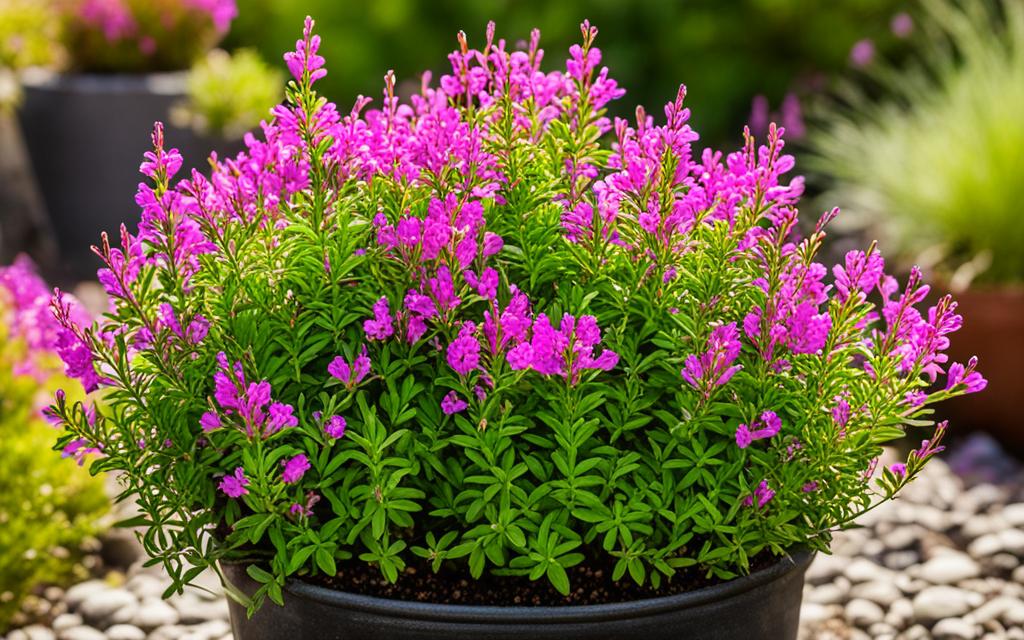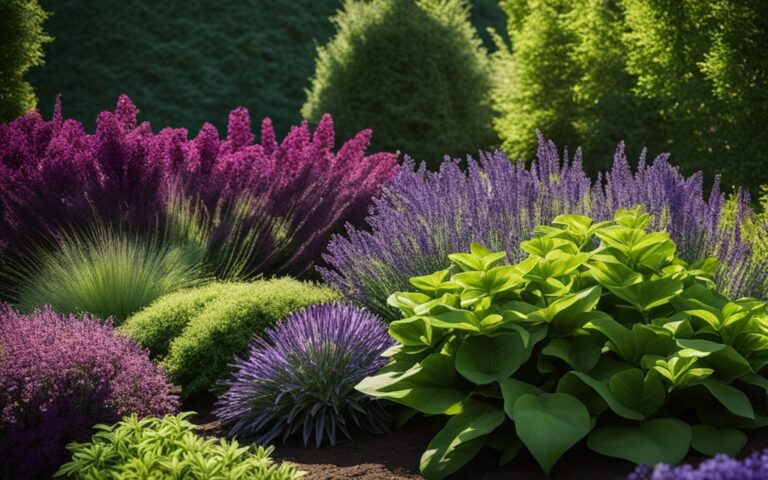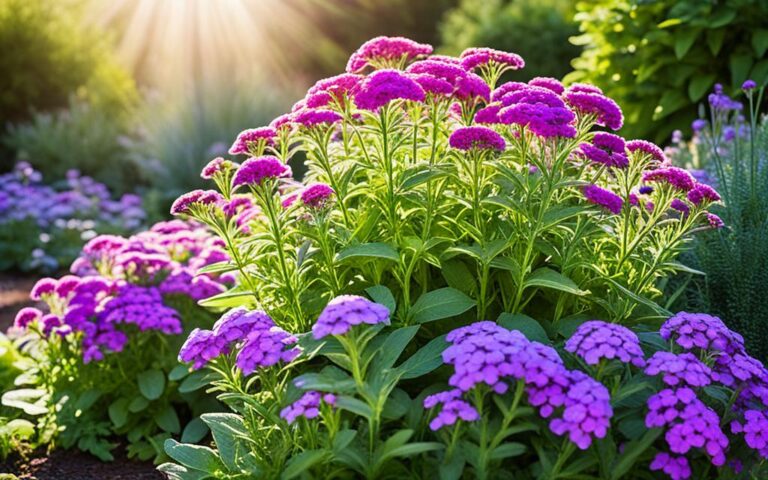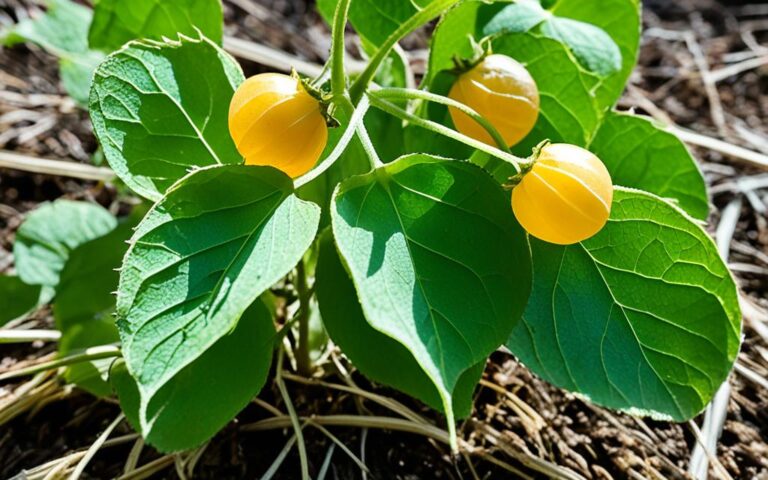Mexican Heather Plant: Care and Growing Tips
Did you know one Mexican heather plant can grow up to 3 feet wide? It’s a great choice for small spaces or as a groundcover. This plant, also called false heather or elfin herb, is loved for its bright, trumpet-shaped flowers. These flowers draw in many pollinators in summer and fall.
Key Takeaways
- Mexican heather is a compact, heat-tolerant shrub that thrives in full sun and well-draining soil
- The plant produces showy, trumpet-shaped flowers in a variety of colors, including purple, white, and pink
- Mexican heather is easy to propagate through seeds, cuttings, or division, making it a versatile choice for gardeners
- Pruning and proper watering are essential for maintaining the plant’s shape and health
- Mexican heather can serve as an attractive, low-maintenance ground cover or be used in mixed borders and containers
What is a Mexican Heather Plant?
The Mexican heather, known as Cuphea hyssopifolia, belongs to the Lythraceae family. It’s a perennial shrub that grows 12-18 inches tall and 12-36 inches wide. People often call it Mexican heather, false heather, or elfin herb.
Common Names and Botanical Classification
The Cuphea hyssopifolia is part of the Cuphea genus, with over 200 plants native to Central and South America. It’s in the Lythraceae family, also known as the loosestrife family.
Plant Type and Mature Size
This shrub is a perennial that reaches 12-18 inches tall and 12-36 inches wide. Its compact size makes it perfect for front borders, containers, and groundcover.
“Mexican heather can grow up to 2 feet high and spread up to 3 feet wide.”
Its blooms, mostly purple but sometimes magenta or white, draw in birds, butterflies, hummingbirds, and moths from spring to fall.
Mexican Heather Plant Varieties and Cultivars
The Mexican heather plant, known as Cuphea hyssopifolia, comes in many varieties and cultivars. Each one has its own special traits. Whether you want bright flowers, small plants, or versatile landscaping, there’s a Mexican heather for you.
The ‘FloriGlory™ Corazon’ is a favorite, with light violet-purple flowers that stand out. Another hit is the ‘Mexican Heather White’, loved for its fast growth and lots of white flowers. It’s a top pick for Florida gardens.
If you like bright colors, try the ‘FloriGlory Diana’ cultivar. It has big magenta flowers that grab attention. These plants grow 12 to 18 inches tall and wide, spreading out to cover the ground with leaves and flowers.
No matter the variety, Mexican heather loves full sun to partial shade and well-draining soil. They do well in USDA zones 9 through 11, making them great for warm climates. With their bright colors and versatility, Mexican heather adds beauty to any garden.
Anatomy and Features of Mexican Heather
Description of Leaves, Stems, and Flowers
The mexican heather plant stands out with its small, bright green mexican heather leaves and thin mexican heather stems. These features give it a lush look that matches its tiny, trumpet-shaped mexican heather flowers. These flowers come in purple, pink, and white, adding color to gardens and landscapes.
Special Characteristics and Unique Traits
The mexican heather plant is more than just pretty. It also attracts bees and butterflies with its mexican heather flowers. These flowers are full of nectar. This makes the plant great for gardens, helping local wildlife and making ecosystems healthier.
| Characteristic | Description |
|---|---|
| Mexican Heather Leaves | Small, bright green foliage that creates a lush, attractive appearance |
| Mexican Heather Stems | Slender, delicate stems that support the plant’s foliage and flowers |
| Mexican Heather Flowers | Dainty, trumpet-shaped blooms in shades of purple, pink, and white |
| Pollinator Attraction | The plant’s nectar-rich flowers attract bees, butterflies, and other pollinators |
“The Mexican heather plant is a versatile and visually appealing addition to any garden, with its vibrant flowers and ability to attract pollinators.”
Ideal Growing Conditions for Mexican Heather
Mexican heather is a vibrant and resilient plant that does well in certain conditions. Knowing the right amount of sunlight, soil, temperature, and humidity is key. This helps gardeners create the perfect spot for this low-care beauty to grow.
Sunlight Requirements
This plant loves the sun and needs at least 6 hours of direct mexican heather sunlight daily. It does best in full sun but can handle some shade, especially in the hottest part of the day.
Soil Preferences and pH Levels
It likes soil that drains well and is a bit acidic, with a pH between 5.5 and 7.0. Adding compost or other organic stuff to the soil helps keep the mexican heather pH just right.
Temperature and Humidity Needs
Mexican heather does well in warm weather, liking temperatures between 75-85°F (mexican heather temperature). It also handles high mexican heather humidity levels, making it great for gardens in southern areas.
| Growing Condition | Ideal Range |
|---|---|
| Sunlight | 6-8 hours of direct sun per day |
| Soil pH | 5.5 – 7.0 |
| Temperature | 75-85°F |
| Humidity | High humidity levels tolerated |
By knowing the best mexican heather sunlight, mexican heather soil, mexican heather pH, mexican heather temperature, and mexican heather humidity conditions, gardeners can make sure this plant does great. It will grow well and look its best in the garden.
How to Propagate Mexican Heather
Mexican heather, also known as Cuphea hyssopifolia, is easy to grow and propagate. You can increase your plant collection or share it with others by learning how to propagate it. Let’s look at the different ways to grow this tough and dry-tolerant plant.
Propagation by Seeds
Starting Mexican heather from seed is simple. First, soak the seeds in warm water for a few hours to help them germinate. Next, plant the seeds in a potting mix that drains well, keeping the soil moist but not too wet. Put the seed tray in a sunny spot and wait for the seedlings to appear, which should take about 2-3 weeks.
Propagation by Cuttings
Propagating Mexican heather with stem cuttings is a popular method. Choose healthy stems without flowers and cut them at a 45-degree angle just below a leaf node. Then, dip the cut end in rooting hormone to help roots grow. Plant the cuttings in a mix of potting soil, coco coir, and perlite or vermiculite. Keep the cuttings in high humidity, around 100%, until they develop roots, which can take 4-6 weeks.
Propagation by Division
If you already have Mexican heather plants, division is a good way to propagate. In early spring or fall, carefully lift the plant and use a sharp tool to divide the roots. Make sure each section has healthy roots and plant them in well-draining soil at the same depth as before. Water well and watch the new plants grow.
Choosing any propagation method, Mexican heather is a hardy plant that thrives with proper care. By learning how to propagate it, you can multiply your plants and enjoy their beautiful blooms and foliage for many years.
Caring for Mexican Heather Plants
Mexican heather plants need careful attention, especially with watering and fertilizing. With proper care, these plants can flourish in your garden or landscape.
Watering Needs
Mexican heather likes consistent, moderate watering. Let the soil dry out a bit between waterings, but don’t let it wilt. Plants in containers might need more water, especially when it’s hot and dry, to keep the soil from drying out too much.
Water Mexican heather at least three times a week for the first month after planting. Then, you can cut back to twice a week. If it’s very hot and dry, you might need to water more often to keep the soil moist.
Fertilizing Requirements
Give Mexican heather plants a balanced, all-purpose fertilizer a few times during the growing season. This helps them stay healthy and grow well. Use a fertilizer made for flowering plants and follow the instructions for how much to use and when.
Also, add compost or other organic matter to the soil. This slowly releases nutrients and improves the soil’s structure. It ensures your Mexican heather gets the nutrients it needs to do well.
| Watering Needs | Fertilizing Requirements |
|---|---|
|
|
Pruning and Training Mexican Heather
Pruning is key to keeping your Mexican heather plants in top shape. It helps them grow bushier and maintain their shape. A light trim in early spring can make a big difference.
To prune your Mexican heather, use clean, sharp pruning shears. Here’s what to do:
- Remove any dead or wayward stems, cutting them back to the base of the plant.
- Trim the plant to the desired shape, avoiding woody areas to help regrowth.
- Lift the tops of the plant to trim the undergrowth and prevent overcrowding.
- Disinfect your pruning shears with rubbing alcohol or a cleaning solution before and after each use to prevent disease spread.
In warmer climates, pruning summer blooms in the fall can encourage new growth. But don’t overdo it, as too much pruning can lead to bald spots and less blooming.
Training Mexican heather makes it a great choice for bonsai. Pruning and wiring the branches can shape it into a beautiful miniature. Just remember to disinfect your tools and be gentle to avoid harm.
By following these prune mexican heather and train mexican heather tips, your plants will look great and bloom well all season.
Common Pests and Diseases
Mexican heather plants are usually tough and easy to care for. But, they can sometimes face pests and diseases. Knowing how to spot and treat these issues is crucial to keep your plants healthy and looking great.
Identifying and Treating Pests
Aphids and spider mites are common pests that can bother Mexican heather. These tiny bugs can make the plant look bad, grow poorly, and even kill it if not stopped. To deal with mexican heather pests, you can use insecticidal soap or other organic solutions. Keeping the plants well-spaced and well-ventilated can also help keep pests away.
Preventing and Managing Diseases
Mexican heather can get diseases like powdery mildew and root rot if the soil is too wet or drains poorly. To prevent mexican heather diseases, make sure the soil drains well, don’t water from above, and keep plants spread out. If a disease happens, using a fungicide quickly can help save the plant.
By keeping an eye out and acting fast on mexican heather pests or diseases, you can keep enjoying the beauty and easy care of this plant.
| Pest/Disease | Symptoms | Treatment |
|---|---|---|
| Aphids | Discolored, stunted growth | Insecticidal soap |
| Spider Mites | Webbing, leaf discoloration | Insecticidal soap |
| Powdery Mildew | White, powdery growth on leaves | Fungicide |
| Root Rot | Wilting, yellowing leaves | Improve drainage, fungicide |
Benefits of Growing Mexican Heather
Looking to brighten up your garden with ease? Consider Mexican heather (Cuphea hyssopifolia). It’s a top pick for gardeners and landscapers. This plant brings many benefits to your garden.
Mexican heather is known for its eye-catching blooms. These come in colors like purple, pink, and white. They cascade beautifully, perfect for ground covers, borders, or containers.
This plant is also easy to care for and can handle dry spells. It loves the sun and is great for warm climates. So, it’s perfect for gardeners who want a beautiful plant with little work.
It’s a magnet for bees and butterflies too. The flowers are full of nectar, helping these pollinators thrive. This boosts your garden’s health and beauty.
Plus, it’s a Texas Superstar. This means it’s top-notch for the state’s varied gardens. It’s adaptable and fits well in many settings.
The benefits of growing Mexican heather are clear. It’s a great choice for adding color and charm to your garden. It’s easy to care for and helps pollinators, making it a win-win.
Mexican Heather as a Groundcover
Mexican heather spreads out and forms a mat, making it perfect for groundcover. It can cover garden beds and walkways, suppressing weeds and adding color. It grows fast, reaching 1-2 feet tall and 2-3 feet wide, filling in gaps quickly.
This plant thrives in warm climates, doing well in USDA zones 9 through 11. It grows to about 12 to 18 inches tall and wide, tolerating various soils and conditions. It’s easy to care for and reliable for landscaping.
Mexican heather blooms a lot, producing purple flowers that draw in pollinators and brighten gardens. With proper care, you can enjoy its lush look and vibrant flowers for many years.
| Variety | Size | Growth Rate | USDA Zones |
|---|---|---|---|
| Purple Mexican Heather | 1-2 feet tall, 2-3 feet wide | Fast, 6-12 inches per year | 9-11 |
| Allyson Mexican Heather | 12-18 inches tall, 16-18 inches wide | Moderate | 9-11 |
Using Mexican heather as groundcover creates a lush, easy-care landscape. It offers year-round interest and practical benefits. Whether you pick the fast-growing Purple Mexican Heather or the compact Allyson variety, it’s a great choice for any garden or outdoor area.
Overwintering Mexican Heather
For gardeners in colder areas, it’s key to know how to overwinter your Mexican heather. This plant, also called Cuphea hyssopifolia, thrives in warm places without frost. But, in cold climates, it needs special care to survive the winter.
If your area gets freezing, consider treating Mexican heather as an annual. Just replant new ones every spring. Or, try keeping potted plants indoors where they can get plenty of sunlight.
- Move potted Mexican heather inside before the first frost. Put them in a window that gets a lot of sun or under grow lights.
- Water them less in winter since they sleep and need less water.
- Trim dead or damaged parts in the fall to help new growth in spring.
- If keeping them outside, cover them with a strong structure or burlap to protect from extreme cold and snow.
With the right care and protection, your Mexican heather can make it through the winter. It will come back in spring, ready to add beauty to your garden with its bright flowers and green leaves.
Mexican Heather Bloom Time and Flower Characteristics
The Mexican heather plant brings joy with its vibrant and fragrant blooms. These start in summer and last until the first frost. They come in purple, pink, and white, making any garden or container look beautiful.
Encouraging More Blooms
To get more beautiful when does mexican heather bloom, make sure your plant gets the right care. It loves rich, well-draining soil and lots of sunlight. Here are some tips for more how to get more mexican heather blooms:
- Add compost or organic matter to the soil to make it richer
- Give the plant at least 6 hours of sunlight every day
- Feed it a slow-release fertilizer in early spring for more flowers
- Remove dead flowers often to make it bloom more
With the right care, your Mexican heather will bloom well during the warm months.
Conclusion
Mexican heather is a vibrant, versatile plant that adds color and charm to gardens. It has delicate flowers and is easy to care for. It’s perfect for gardeners who want to add interest and texture to their landscapes.
Whether you’re experienced or new to gardening, this growing mexican heather guide will help you. It covers everything from its unique traits to how to care for it. You’ll learn how to make your garden look stunning with Mexican heather.
Starting with Mexican heather is exciting. It’s tough and can adapt to different conditions. With the right care, you can enjoy its bright flowers every year. This guide will give you the best tips to care for this beautiful plant.
“Mexican heather is a true delight for the senses, bringing a touch of the tropics to any garden.”
Why not brighten your garden with Mexican heather today? It’s easy to care for and fits well in many settings. This plant will inspire and delight you for years.
Frequently Asked Questions About Mexican Heather
Gardeners often wonder about the Mexican Heather plant. Here are answers to some common questions:
Is Mexican Heather toxic? No, it’s not toxic. It’s safe for gardens where kids play. There’s little research on its effects on humans because it’s harmless. It’s not listed as a harmful plant.
Can Mexican Heather cause skin reactions? Touching it is usually safe, feeling like a butterfly landing on you. But, some people might react badly, which is rare.
How do I care for Mexican Heather? It likes full sun to some shade and moist soil. It’s great for big plantings, regular gardens, or pots. It grows 13 to 24 inches tall and spreads 12 to 24 inches wide.






